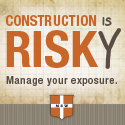BY SCOTT GERARD, VP OF ENVIRONMENTAL, HEALTH & SAFETY
MOSS CONSTRUCTION
In the 1700s, Ben Franklin famously said, "An ounce of prevention is worth a pound of cure." Today, nearly 300 years later, these words ring true, especially for builders during hurricane season, June 1 through November 30.
Contractors across the United States should take hurricane preparedness seriously. Here are a few key tips that could benefit any builder in need of updating or creating a hurricane preparedness plan.
Have a Solid Plan. It’s surprising how many builders do not have a hurricane preparedness plan. If you have yet to create a plan, a good place to start is with OSHA, www.Ready.gov and your insurance carrier, as all can help advise standard practices.
Get to Know Local First Responders. Make it a point to meet with local authorities (police, fire) when you mobilize a project. This helps to determine requirements for permitting personnel to return to the project area after an emergency event. Local authorities may require a listing of essential personnel and proof of identification upon return to the project area...especially in evacuated areas. Also, share your capabilities so that if there’s an emergency you can help with, they know the resources you have.
Develop a List of—and Collect—Needed Supplies. Long before there are any storms on the horizon, develop a checklist of materials you may need. When a storm is approaching, hardware and big box stores will quickly sell out of pumps, power cords and generators. Maintaining shipping containers of emergency supplies ready to be deployed at a moment’s notice is a good idea.
Monitor the Weather. In 1992, a small and seemingly insignificant storm was brewing well off the coast of Florida. Within 48 hours it grew to be Category 5 Hurricane Andrew, barreling into a relatively unprepared Florida coast, killing 65 people and causing $57 billion in damage. Every single day, monitor weather activity. Andrew taught us just how rapidly conditions can change.
Know When to Activate Your Plan. Thankfully, most storm watches, severe thunderstorm watches and hurricane watches, remain just that, watches. After years without a major incident, it can be tempting to ignore or downplay watches and warnings. But, there is an "art to the science" of when to deploy your hurricane preparedness plan. Your jobsites need to be secured with plenty of time for workers and subcontractor employees to get home to prepare their own homes and care for their families. If you wait too long to deploy your plan, you may not have workers available to implement it.
Use a Staged Response. Implement a staged response to weather threats. For instance:
Stage 1: Severe storm conditions (wind speeds of 39-73 mph) could be expected to hit an area within 60 hours;
Stage 2: Hurricane conditions may exist within 36-48 hours in designated areas;
Stage 3: Hurricane conditions are expected to strike within 24-36 hours;
Stage 4: post-hurricane stage for recovery.
Prepare, Prepare, Prepare. Actively engage precautions early. It’s better to be prudent, so at stages 1 and 2:
- -Delay or closely monitor shipments,
- -Group and secure on-site containers,
- -Secure electronics and computer equipment in high, dry areas, away from windows,
- -Make back up copies of all hard drives,
- -Evaluate flooding potential and move vehicles, equipment and materials from low lying areas,
- -Cover windows using approved protective methods,
- -Secure loose materials,
- -Take down scaffolding,
- -Arrange for tipping of dumpsters,
- -Perform a trial run of generators,
- -Fuel all our vehicles,
- -Make arrangements to have cash on hand,
- -Shut off all power, and
- -Document the state of the site with photos and video footage to show precautions taken to avoid damage and the state of pre-hurricane conditions.
Stay Current. Keep Important Paperwork Safe and Handy. Ensure insurance is up to date for the project and obtain a copy of the certificate in addition to the contact information for the carrier/adjuster.
Phone Trees. Do your employees and subs all know how to reach one another? Keep a current phone tree ready to deploy so that everyone knows what is going on and is aware of when it is safe to go back to the site.
Consider Satellite Phones. There will likely be major power outages. You may want to consider satellite phones for key personnel.
Recovery. Designate a recovery team that is prepared to visit the site once it’s safe to do so. Remember most injuries take place in the recovery phase so it’s very important to take precautions, triage projects and stabilize the area before all teams return.
People Need to Take Care of Their Own Home First. Encourage team members to take care of their own families before you expect them to return to work. Don’t assign jobs to specific individuals. Instead, designate those tasks to team members who are able to respond and work together. If someone is especially hard hit, they can count on their teammates to step in until they have handled any crises at home.
Drill and Practice. Ideally, you’ll never need to implement your plan. But, it’s critical to have an annual drill and be open to continuously updating and modifying your plan. Conduct a table top exercise for an annual hurricane/storm drill and revise the plan accordingly.
It has been 129 months, nearly 11 years, since a major Category 3 or larger hurricane has made landfall in the United States. We cannot let this influence our preparations. Time spent preparing for a hurricane that fails to surface is still time well spent. It’s inevitable that we will find ourselves in a major hurricane at some point. But with years of preparations, having a team in place will help to weather any storm.
Scott Gerard serves as Moss Construction’s VP of Environmental, Health & Safety. Moss Construction, a South Florida Chapter-AGC member, is a privately held construction firm providing innovative solutions resulting in award-winning projects across the United States.

 2300 Wilson Boulevard, Suite 300 · Arlington, VA 22201 · 703-548-3118 (phone) · 703-548-3119 (fax) · www.agc.org
2300 Wilson Boulevard, Suite 300 · Arlington, VA 22201 · 703-548-3118 (phone) · 703-548-3119 (fax) · www.agc.org
 Safety Conference Addresses Silica and Recordkeeping Regulations, Reveals Unique AGC Research on Fatalities
Safety Conference Addresses Silica and Recordkeeping Regulations, Reveals Unique AGC Research on Fatalities



